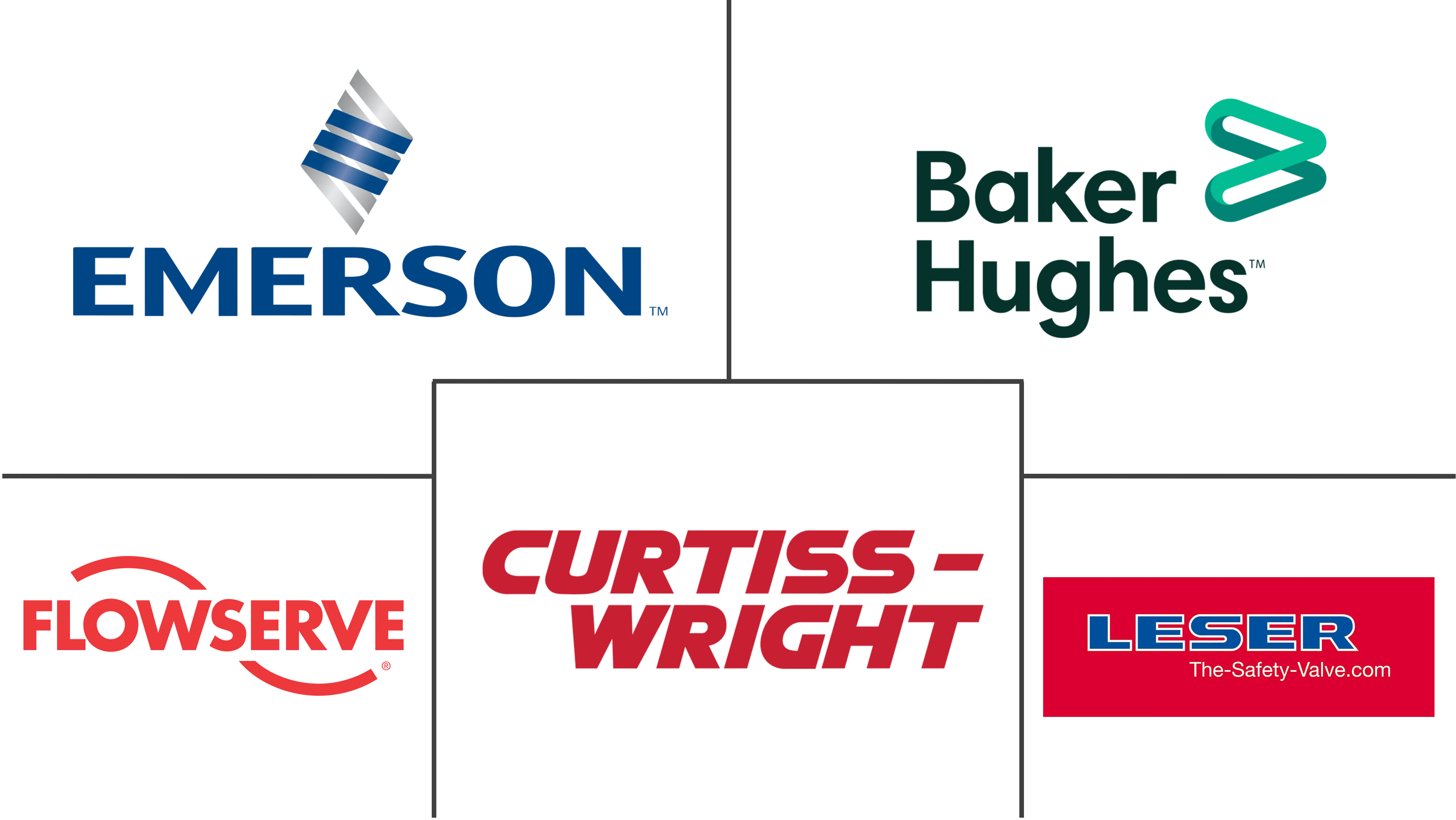Global Pressure Relief Valves Market Size and Share
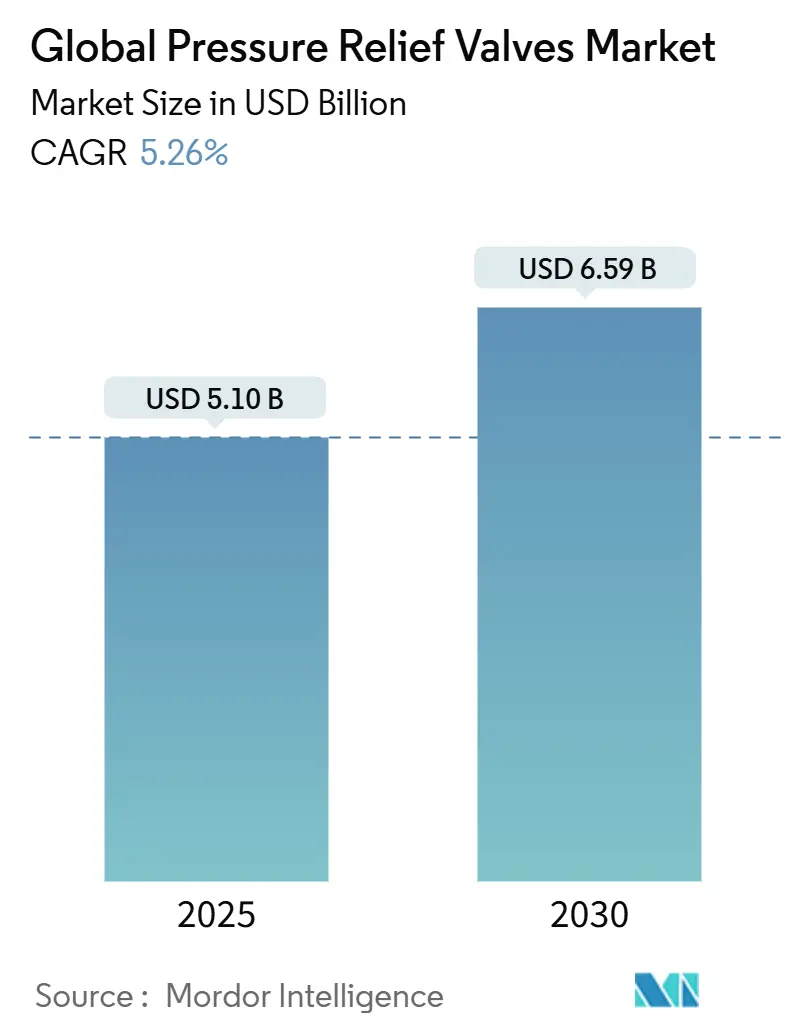
Global Pressure Relief Valves Market Analysis by Mordor Intelligence
The pressure relief valves market size is valued at reached USD 5.1 billion in 2025 and is forecast to advance to USD 6.59 billion by 2030, generating a 5.26% CAGR during the period. The outlook reflects compulsory adherence to API 526 and ASME rules in process plants, rapid construction of LNG and hydrogen facilities, and expanding pharmaceutical capacity that requires sanitary-grade over-pressure protection. Intensifying modernization of brownfield refineries in the Middle East, coupled with rising deployment of digital maintenance systems, further underpins demand for smart, HART- or IIoT-enabled devices. Pilot-operated designs post the quickest uptake at 7.8% CAGR given their higher capacity and tighter emissions control, whereas spring-loaded variants continue to supply the broad installed base. Regionally, Asia-Pacific leads on the back of heavy chemical, pharmaceutical, and hydrogen investments, while Middle Eastern projects generate the briskest growth as aging assets undergo full valve replacement cycles.
Key Report Takeaways
- By product type, spring-loaded units held 47.2% of pressure relief valves market share in 2024; pilot-operated devices are rising at a 7.8% CAGR toward 2030.
- By valve size, the medium (2"–6") category delivered 41.5% revenue share in 2024; large-bore formats above 6" are forecast to expand at an 8.2% CAGR.
- By set pressure, medium-pressure models (150–600 psi) accounted for 41.5% of the pressure relief valves market size in 2024, while high-pressure units above 600 psi show an 8.2% CAGR.
- By material, stainless-steel grades dominate corrosive and high-purity duties with the widest installed base.
- By end user, oil and gas contributed 32.8% revenue in 2024; pharmaceutical and biotech demand is advancing at an 8.9% CAGR.
By geography, Asia-Pacific led with 34.6% share in 2024; the Middle East records the fastest 7.6% CAGR through 2030.
Global Pressure Relief Valves Market Trends and Insights
Drivers Impact Analysis
| DRIVER | (~) % IMPACT ON CAGR FORECAST | GEOGRAPHIC RELEVANCE | IMPACT TIMELINE |
|---|---|---|---|
| Rapid LNG & Hydrogen Infrastructure Expansion Demanding High-Integrity Over-Pressure Protection | +1.8% | Global, with early gains in Asia-Pacific, North America, Middle East | Medium term (2-4 years) |
| Mandatory API 526/ASME Compliance in North America & EU Process Industries | +1.2% | North America & EU core, spill-over to emerging markets | Long term (≥ 4 years) |
| Brownfield Revamps of Ageing Refining Assets Across Middle East Elevating Valve Replacement Cycles | +0.9% | Middle East core, selective applications in Latin America | Short term (≤ 2 years) |
| Growth of Smart Manufacturing Driving Demand for Digital-Enabled Safety Valves (HART, IIoT) | +0.7% | Global, with concentration in developed markets | Medium term (2-4 years) |
| Accelerating Pharmaceutical Capacity Adds in India & China Requiring Sanitary PRVs | +0.6% | Asia-Pacific core, particularly India and China | Short term (≤ 2 years) |
| Nuclear Power Plant Modernization and Safety Upgrades Requiring Advanced Pressure Relief Systems | +0.5% | Global, with focus on North America, Europe, Asia-Pacific | Long term (≥ 4 years) |
| Source: Mordor Intelligence | |||
Rapid LNG & Hydrogen Infrastructure Expansion Demanding High-Integrity Over-Pressure Protection
Massive investment in LNG import terminals and green hydrogen projects is lifting demand for pressure relief devices engineered for cryogenic temperatures to –162 °C and for hydrogen service pressures up to 700 bar. UN Global Technical Regulation 13 obliges thermal pressure relief devices able to survive external fire while preventing tank rupture, pushing suppliers to adopt fire-resistant alloys and fast-acting discharge geometries. European Industrial Gases Association guidance also stresses accurate vent sizing and structural resilience for outdoor hydrogen stacks. Equipment such as Emerson’s TESCOM HV-7000 regulator targets contamination-free operation to extend service life in 700-bar vehicle storage. As a result, the pressure relief valves market gains clear volume and value upside from these emerging energy chains.[1]United Nations, “Global Technical Regulation 13,” unece.org
Mandatory API 526/ASME Compliance in North America & EU Process Industries
The 2025 ASME BPVC removes the two-class vessel system and revises Appendix 47, raising design scrutiny for pressure equipment and reinforcing demand for code-certified valves. API 526 standardizes orifice sizes and center-to-face dimensions, easing retrofit but tightening acceptance criteria. Studies show that up to 85% of valve performance issues link to deviations from prescribed sizing, installation, or maintenance, placing new emphasis on OEM-led training and support. Pressure Equipment Directive 2014/68/EU requires each device above 0.5 bar to pass conformity assessment by notified bodies, leading to longer lead times yet driving preference for suppliers with in-house compliance teams.
Brownfield Revamps of Aging Refining Assets Across Middle East Elevating Valve Replacement Cycles
Many Middle Eastern refineries built during earlier expansion phases now face higher sulfur crudes and tighter emission norms, forcing large-scale safety system upgrades. Kuwait Oil Company’s program covering 14 gathering centers illustrates the complexity of inserting new units without interrupting output, thus favoring modular, quick-install pressure relief packages. Saudi projects awarded to Darvico for Masoneilan Series 84K valves highlight increased demand for high-temperature steam duties. Rotork actuator retrofits at Tupras Izmit used more than 900 intelligent units, confirming the wider adoption of smart control even in replacement work.
Growth of Smart Manufacturing Driving Demand for Digital-Enabled Safety Valves (HART, IIoT)
Industry 4.0 projects integrate pressure relief valves into digital twins that track stroke counts, seat leakage, and spring fatigue in real time. Wireless transmitters such as OleumTech HGPT offer ±0.075% accuracy over 5–6,000 psi, enabling condition-based maintenance strategies that reduce unplanned downtime. Emerson’s Rosemount 3051 deployment base of more than 10 million illustrates rising confidence in digitally connected measurement. As data transparency aligns with corporate ESG and safety targets, digital compatibility becomes a decisive specification factor in the pressure relief valves market.
Restraints Impact Analysis
| RESTRAINTS | (~) % IMPACT ON CAGR FORECAST | GEOGRAPHIC RELEVANCE | IMPACT TIMELINE |
|---|---|---|---|
| Margin Squeeze from Proliferation of Low-Cost Asian Valve OEMs | -0.8% | Global, with concentration in price-sensitive markets | Medium term (2-4 years) |
| Substitution by Rupture Discs in Single-Use Bioprocessing Skids | -0.6% | Global, particularly in pharmaceutical and biotech sectors | Short term (≤ 2 years) |
| Volatile Nickel & Stainless-Steel Prices Disrupting Cost Structures | -0.5% | Global manufacturing, with regional variations | Short term (≤ 2 years) |
| Extended Certification Lead-Times (PED, CRN) Delaying Project Awards | -0.4% | Europe and North America primarily | Medium term (2-4 years) |
| Source: Mordor Intelligence | |||
Margin Squeeze from Proliferation of Low-Cost Asian Valve OEMs
Asian suppliers now produce API- and ASME-compliant pressure relief valves at lower cost, compressing margins for incumbents. To stay competitive, Western brands emphasize advanced materials, predictive diagnostics, and full life-cycle support that low-price entrants struggle to match. Price pressure is most acute in commodity low-pressure applications, whereas nuclear, aerospace, and severe-service hydrogen duties still reward premium engineering.
Substitution by Rupture Discs in Single-Use Bioprocessing Skids
Single-use bioreactors rise in popularity because disposable liners cut cleaning validation time. Rupture discs provide sterile one-time protection and avoid moving parts, reducing contamination risk. Nonetheless, discs require replacement after activation and cannot reseat, creating higher consumable costs compared with pressure relief valves that reseal, limiting substitution to batch operations.
Segment Analysis
By Product Type: Reliability of Spring-Loaded Designs Meets Rise of Pilot-Operated Technology
Spring-loaded valves retained the largest position with 47.2% share in 2024, reflecting decades of installed equipment across pressure bands from 4 psig to 6,250 psig and temperatures down to −450 °F. Cost-effective construction, simple maintenance, and high availability keep demand stable across refineries, chemical plants, and power boilers. Pilot-operated units are forecast to grow 7.8% CAGR as operators prioritize tighter leakage control and larger capacity within compact footprints. Feature sets such as remote sense lines and modulating disc action align with digital pressures for lower methane emissions and improved process efficiency, reinforcing their uptake in the pressure relief valves market.
Baker Hughes’ Consolidated Type 2900 platform exemplifies hybrid flexibility, permitting field conversion between modes to suit changing process conditions. Niche devices―dead-weight, buckling pin, and balanced bellows―address custody transfer, tamper-proof calibration, or back-pressure mitigation, yet their aggregate volume remains modest. Suppliers therefore steer R&D toward pilot-operated enhancements and smart actuator integration where incremental performance justifies premium pricing.[2]Baker Hughes, “Consolidated Type 1900 Safety Relief Valve,” valves.bakerhughes.com
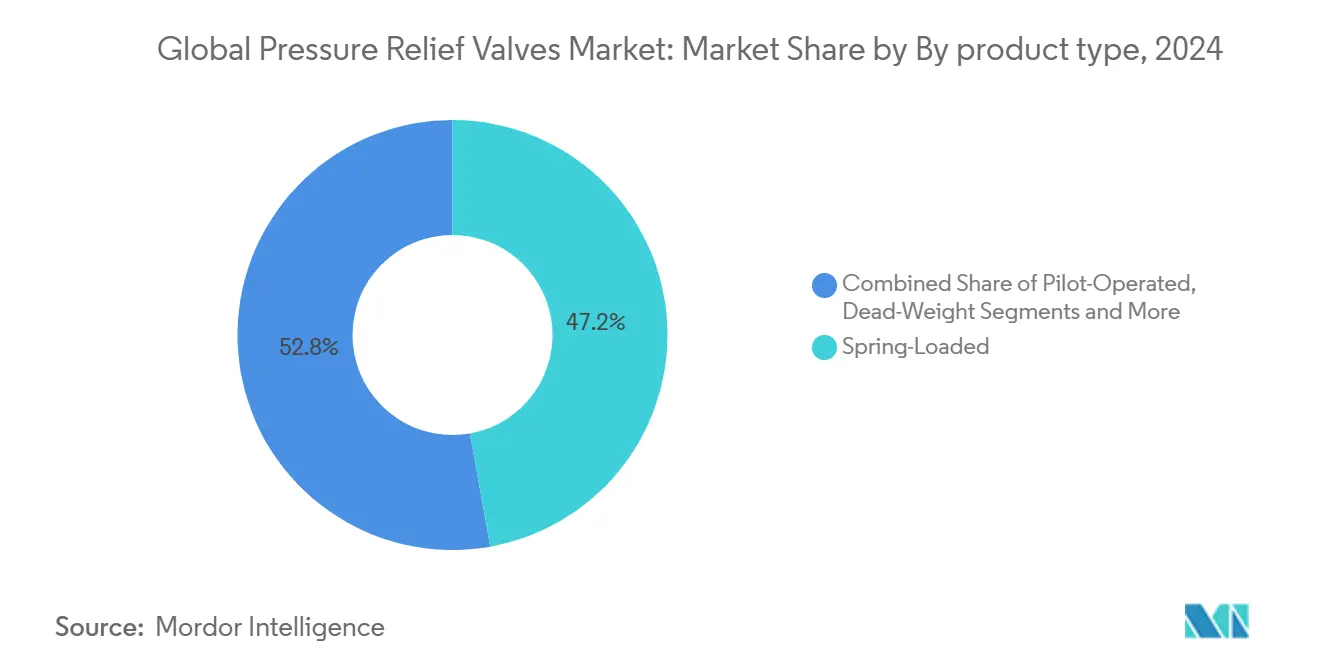
Note: Segment shares of all individual segments available upon report purchase
By Valve Size: Large-Bore Valves Capture Infrastructure Upsizing
Medium size (2"–6") valves contributed 41.5% revenue in 2024, covering mainstream flow demands in oil, chemical, and power plants. However, the large-bore segment above 6" is projected to rise at 8.2% CAGR to 2030 as LNG terminals, gas pipelines, and mega-scale hydrogen hubs command greater discharge areas for credible relief. Emerson’s Fisher EZR series spans bodies up to NPS 8 with 1,050 psig inlet rating, marrying high capacity with fine pressure control.
Engineering challenges scale rapidly with diameter: weight, nozzle reaction forces, and noise require special attention, and only vendors with extensive foundry and test capacity can compete. Small valves under 2" persist in laboratory, instrumentation, and pharmaceutical skids where space, cleanliness, and accurate low-flow performance overrule volume throughput.[3]Emerson, “Fisher Type EZR Relief Valve,” emerson.com
By Set Pressure: Intensifying Processes Propel High-Pressure Growth
Medium-pressure devices between 150 and 600 psi held 41.5% of pressure relief valves market share in 2024. They remain the workhorse of conventional refining and steam service. High-pressure versions above 600 psi exhibit an 8.2% CAGR owing to hydrogen compression, supercritical CO₂, and advanced ethylene crackers requiring over-pressure protection up to 1,000 bar.
Materials such as Inconel and Hastelloy ensure mechanical strength and resistance to hydrogen embrittlement, though they elevate price. Low-pressure offerings under 150 psi find steady demand in water treatment, HVAC, and food processing. Suppliers optimize disc profiles and spring characteristics to reach fast reseat at narrow blowdown margins, essential for reduced product discharge loss in costly media.
By Material: Stainless Steel Retains Primacy Amid Specialty Alloy Uptake
Austenitic stainless-steel grades SS304/SS316 dominate applications where corrosion resistance, hygiene, and ease of cleaning matter, covering a broad cross-section of chemical, food, and pharma lines. Carbon steel stays relevant for non-corrosive duties because of its lower cost, though new environmental norms drive conversion to coated or clad bodies in many refineries. Exotic alloys such as Monel or duplex stainless support sour-gas, high-chloride, or hydrogen duties, with growth following deeper CO₂ sequestration and green ammonia projects.
Material choice now influences total cost of ownership more than initial capex. Operators weigh downtime, inspection intervals, and cleaning frequency when selecting higher-grade metals, favoring suppliers who offer documented lifecycle data.
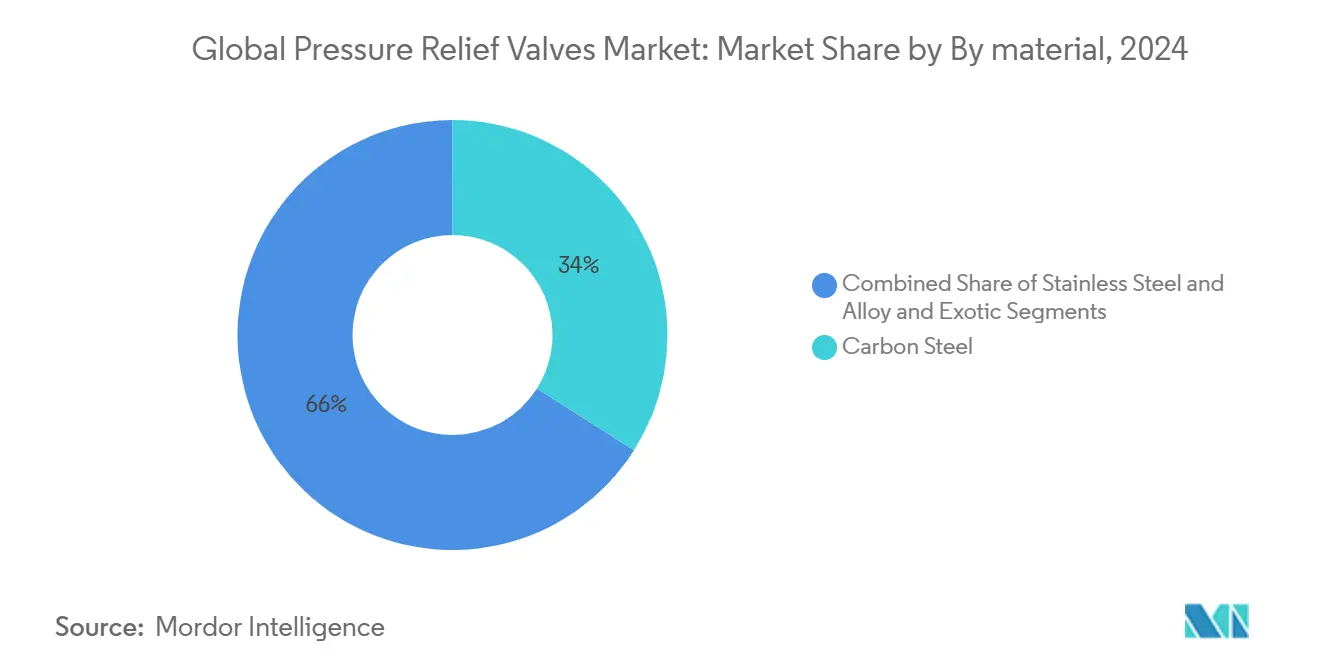
Note: Segment shares of all individual segments available upon report purchase
By End-User: Pharmaceutical and Biotech Offer Highest CAGR
Oil and gas maintained leadership at 32.8% revenue in 2024 because of sheer asset base from upstream wells to downstream refineries. Chemical and petrochemical complexes follow closely, while power generation spans traditional steam plants and emerging nuclear small modular reactors. Pharmaceutical lines register the fastest 8.9% CAGR as multi-product biologics facilities proliferate in Asia-Pacific, each needing traceable, clean-in-place relief devices.
Food, beverage, and water utilities round out demand for sanitary and low-pressure offerings. Pulp and paper mills continue to retrofit for tighter fugitive-emission limits, adding incremental replacement orders and sustaining aftermarket revenue for OEMs within the pressure relief valves market.
Geography Analysis
Asia-Pacific generated 34.6% of global revenue in 2024 and remains the cornerstone of volume growth. Chinese and Indian investments in hydrogen, LNG import, and bulk pharmaceutical production give local assemblers scale while drawing in Western OEM technology under license. Japan and South Korea add demand from advanced chemical and nuclear sectors that require high purity and seismic-qualified safety valves. Local certification schemes converge with API and ASME, easing export of Asia-fabricated devices and expanding the regional pressure relief valves market.
The Middle East exhibits the quickest 7.6% CAGR through 2030 as brownfield refinery overhauls underpin large, lump-sum valve replacement programs. Saudi-led mega-refining projects and the UAE’s diversification into petrochemicals widen the call for high-capacity, high-temperature safety devices. Regional governments also back green hydrogen export hubs, further expanding high-pressure valve demand.
North America maintains steady expansion based on stringent OSHA and EPA compliance, plus shale gas midstream infrastructure upgrades. Europe emphasizes PED conformity and decarbonization, encouraging adoption of valves compatible with hydrogen and carbon-capture media. Latin America delivers episodic project awards in refining and mining, while Africa offers early-stage opportunities tied to LNG export terminals. Across all geographies, digital monitoring and predictive maintenance features increasingly factor into procurement decisions, reinforcing technology differentiation in the pressure relief valves market.
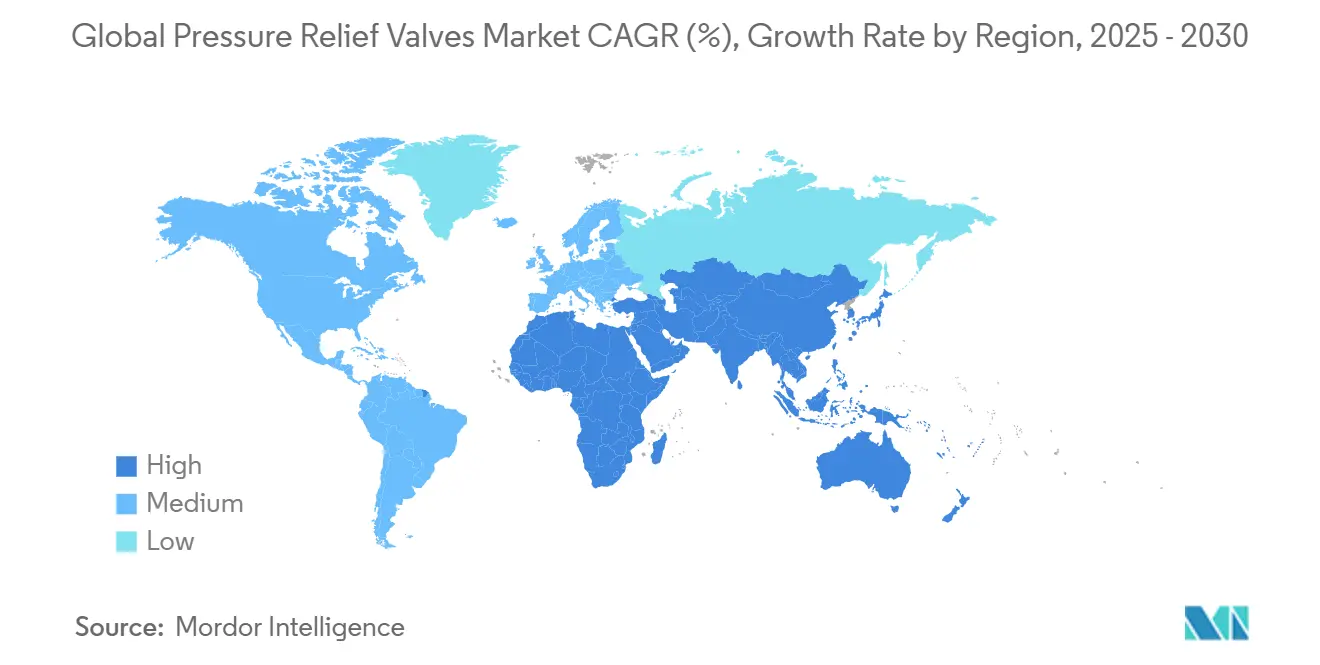
Note: Segment shares of all individual segments available upon report purchase
Competitive Landscape
Global supply is moderately concentrated around diversified flow-control groups that combine broad product lines with worldwide service. Emerson leads through Crosby and Anderson Greenwood brands, offering conventional to pilot-operated valves alongside wireless acoustic monitors that detect simmer before lift. Baker Hughes leverages Consolidated valves plus a Green Tag Center network for certified repairs, turning aftermarket into a recurring revenue engine.
Flowserve expanded severe-service portfolio by acquiring MOGAS for USD 290 million, reflecting a strategy to dominate niche, high-pressure, slurry, and mining segments. Crane Company agreed to buy Precision Sensors & Instrumentation for USD 1.06 billion to marry measurement and relief technologies, signifying convergence between sensing and safety functions.
Low-cost Chinese and Indian manufacturers challenge incumbents in commodity spring-loaded offerings, yet high regulatory barriers in nuclear, hydrogen, and pharmaceutical applications preserve price premiums for established brands. The capital intensity of casting, machining, and high-pressure test rigs limits new entrants. Suppliers thus differentiate through digital diagnostics, rapid PED/CRN certification support, and field-service footprints that de-risk operator downtime, sustaining competitive equilibrium within the pressure relief valves market.
Global Pressure Relief Valves Industry Leaders
-
Emerson Electric Co.
-
Baker Hughes Company
-
Curtiss-Wright Corp.
-
LESER GmbH & Co. KG
-
Flowserve Corporation
- *Disclaimer: Major Players sorted in no particular order
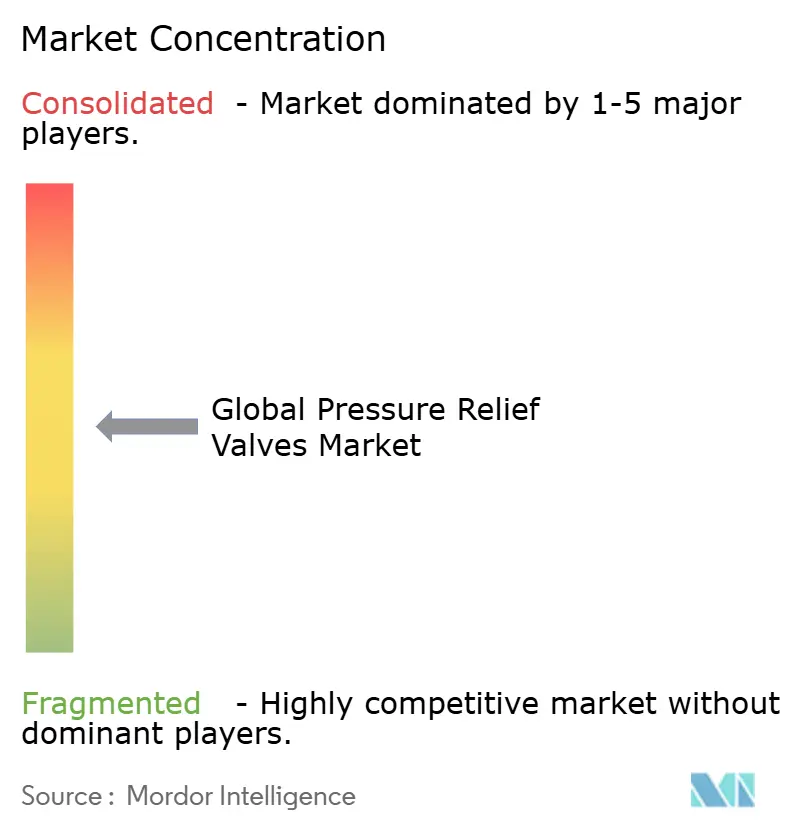


Recent Industry Developments
- September 2025: Crane Company announced acquisition of Precision Sensors & Instrumentation from Baker Hughes for USD 1.06 billion, strengthening pressure sensing capabilities particularly in aerospace and nuclear applications with projected 2025 sales of USD 390 million.
- March 2025: U.S. Nuclear Regulatory Commission issued draft NUREG-1482 Revision 4 establishing updated guidelines for inservice testing of pumps and valves at nuclear power plants, incorporating lessons learned and operating experience.
- June 2025: ONGC announced feasibility study for greenfield refinery in Jamnagar, Gujarat, in collaboration with Saudi Arabia for crude oil supply, representing potential major infrastructure development requiring extensive pressure relief systems.
Global Pressure Relief Valves Market Report Scope
A pressure relief valve is a type of safety valve used to control or limit the pressure in a system. The pressure relief valves market is segmented by product type, set pressure, end-user, and geography. By product type, the market is segmented into pilot-operated, spring-loaded, dead weight, and others. By set pressure, the market is segmented into high-pressure medium pressure and low pressure. By end-user, the market is segmented into oil & gas, chemical processing, power generation, paper & pulp, food & beverages, pharmaceuticals, and others. The report also covers the market size and forecasts for the pressure relief valves market in 14 countries across major regions. For each segment, the market sizing and forecasts have been done based on revenue.
| Spring-Loaded |
| Pilot-Operated |
| Dead-Weight |
| Buckling Pin |
| Balanced Bellows |
| Up to 2 inch |
| 2 inch - 6 inch |
| Above 6 inch |
| Low (less than 150 psi) |
| Medium (15 - 600 psi) |
| High (greater than 600 psi) |
| Carbon Steel |
| Stainless Steel |
| Alloy and Exotic |
| Oil and Gas (Upstream, Midstream, Downstream) |
| Chemical and Petrochemical |
| Power Generation (Thermal, Nuclear, Renewables-Hydrogen) |
| Pulp and Paper |
| Food and Beverage |
| Pharmaceuticals and Biotech |
| Water and Waste-Water |
| North America | United States |
| Canada | |
| Mexico | |
| Europe | United Kingdom |
| Germany | |
| France | |
| Italy | |
| Rest of Europe | |
| Asia-Pacific | China |
| Japan | |
| India | |
| South Korea | |
| Rest of Asia | |
| Middle East | Israel |
| Saudi Arabia | |
| United Arab Emirates | |
| Turkey | |
| Rest of Middle East | |
| Africa | South Africa |
| Egypt | |
| Rest of Africa | |
| South America | Brazil |
| Argentina | |
| Rest of South America |
| By Product Type | Spring-Loaded | |
| Pilot-Operated | ||
| Dead-Weight | ||
| Buckling Pin | ||
| Balanced Bellows | ||
| By Valve Size (Inch) | Up to 2 inch | |
| 2 inch - 6 inch | ||
| Above 6 inch | ||
| By Set Pressure | Low (less than 150 psi) | |
| Medium (15 - 600 psi) | ||
| High (greater than 600 psi) | ||
| By Material | Carbon Steel | |
| Stainless Steel | ||
| Alloy and Exotic | ||
| By End-User | Oil and Gas (Upstream, Midstream, Downstream) | |
| Chemical and Petrochemical | ||
| Power Generation (Thermal, Nuclear, Renewables-Hydrogen) | ||
| Pulp and Paper | ||
| Food and Beverage | ||
| Pharmaceuticals and Biotech | ||
| Water and Waste-Water | ||
| By Geography | North America | United States |
| Canada | ||
| Mexico | ||
| Europe | United Kingdom | |
| Germany | ||
| France | ||
| Italy | ||
| Rest of Europe | ||
| Asia-Pacific | China | |
| Japan | ||
| India | ||
| South Korea | ||
| Rest of Asia | ||
| Middle East | Israel | |
| Saudi Arabia | ||
| United Arab Emirates | ||
| Turkey | ||
| Rest of Middle East | ||
| Africa | South Africa | |
| Egypt | ||
| Rest of Africa | ||
| South America | Brazil | |
| Argentina | ||
| Rest of South America | ||


Key Questions Answered in the Report
What is driving the current expansion of the pressure relief valves market?
Mandatory API and ASME compliance, LNG and hydrogen infrastructure, and smart manufacturing initiatives collectively lift global demand.
Which product type is growing fastest?
Pilot-operated pressure relief valves record a 7.8% CAGR to 2030 as users target higher capacity and lower fugitive emissions.
Why is Asia-Pacific the largest regional market?
China and India invest heavily in refining, chemicals, and pharmaceuticals, requiring large volumes of code-compliant relief devices.
How do digital technologies influence valve purchasing?
HART- and IIoT-enabled valves provide real-time diagnostics and predictive maintenance, lowering downtime and aligning with Industry 4.0 goals.
What challenges threaten market growth?
Price competition from low-cost Asian OEMs, raw-material volatility, and extended PED or CRN certification cycles can trim profit margins.
Which end-user sector shows the highest growth potential?
Pharma and biotech applications deliver an 8.9% CAGR due to sanitary requirements and rising biologics production capacity.
Page last updated on:
